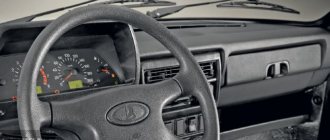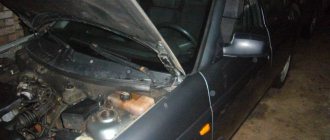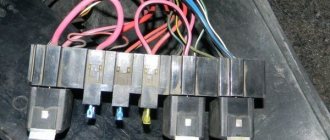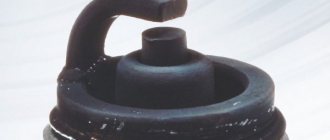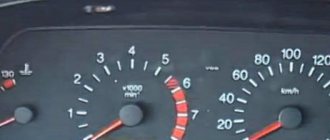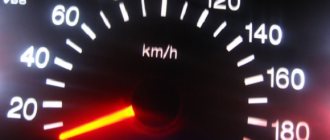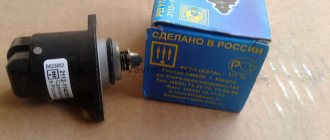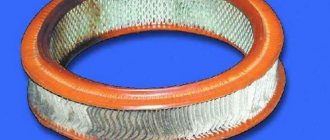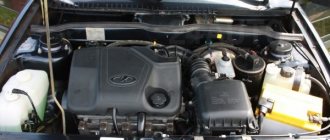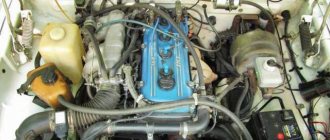When cold, the VAZ 2114 engine starts and immediately stalls
The operation of the injection system has always been a weak point of VAZ cars. Low-quality gasoline, counterfeit consumables, inept repairs done by yourself or unprofessional service - the car stalls for any of these reasons.
On older cars of the Samara-1 generation, a similar problem was solved by adjusting the carburetor and ignition. Less commonly, replacing the fuel pump. The electronic injector of the VAZ 2114 is many times more reliable than a carburetor; it starts and works in any weather without causing any trouble.
But if the injection machine still stalls, there can be many reasons for this.
The engine starts and stalls: troubleshooting
So, if a similar problem appears, then it is necessary to take into account a number of features. First of all, the operation of the internal combustion engine after startup will be influenced by the following factors:
- fuel supply;
- air supply;
- spark on spark plugs (for gasoline internal combustion engines);
- correct operation of glow plugs (for diesel engines);
- proper operation of the ECM and electronic sensors;
With that said, you should first start by checking the main possible causes:
- Quite often, malfunctions in the operation of the alarm system and the anti-theft system can cause the engine to fail to operate after starting. In other words, the immobilizer does not turn off and continues to block the start of the internal combustion engine, which is its main function to prevent vehicle theft. If the alarm blocks the engine, then you need to check the operation of all elements, try to reset the error, turn off the anti-theft system, etc.
- Problems with the IAC and idle air valve often arise due to contamination of these elements. You should also pay attention to the cleanliness of the throttle valve. As for the crankshaft sensor, incorrect data that it transmits to the ECU can cause the engine to stall immediately after starting.
- Poor quality fuels and lubricants can also cause problems. As a rule, problems begin in cases where low-grade fuel was filled or the engine uses motor oil that does not meet the recommendations/has lost its properties.
- A faulty fuel pump, air leaks in the fuel line, the formation of air pockets and dirty fuel filters do not allow creating the required pressure in the power system or supplying fuel in the required volume.
- The air filter and its contamination leads to the fact that the working mixture is significantly over-rich. In other words, the engine does not have enough air to burn fuel, and the spark plugs flood.
- Problems with ECM sensors (EGR sensor, oxygen sensor, DPKV, etc.) can lead to both unstable engine operation at idle and a complete engine stop after starting.
INDEPENDENT DIAGNOSTICS IN THE GARAGE
If you have problems with the operation of the injection system, you should first diagnose the ECU. In this regard, the owners of the VAZ 2114 are more fortunate with the German VDO instrumentation - it has a self-diagnosis mode. On cars with a dashboard from Schetmash there is no such functionality.
VDO dashboard for VAZ 2114
Working with the self-diagnosis mode on the VDO panel is carried out according to the following algorithm:
- With the ignition off, hold the odometer button for several seconds;
- turn the ignition to position “1”, release the button;
- if the arrows start running on the display, everything is fine, press once (information message about the firmware version) and release, with a second press an error code will appear;
- You can reset the error by holding the button until “0” appears.
Injection problems that cause the car to stall can be indicated by the numbers 1 (ECU error), 14,15 (coolant sensor errors), 22, 23 (DPS errors), 33, 34 (MAF errors), 42 (ignition malfunction) , 44, 45 (lean or rich mixture). The disadvantage of self-diagnosis on the VAZ 2114 is that if there are several errors, the system sums up the codes. Thus, the number “22” may mean a TPS error or low on-board voltage and a coolant sensor error (8 + 14).
For more accurate diagnostics of the injector, you need to immediately contact a service center or purchase a diagnostic scanner (it costs about 1000 rubles).
If you have another car, you can find the problematic sensor by replacing the sensitive elements one by one with known good ones.
DIAGNOSTICS FOR HEARING AND EYE
External signs can sometimes tell more about injection problems than computer diagnostics.
Pay attention to exactly when the VAZ 2114 car stalls:
- at idle;
- the car does not start well, stalls immediately after starting, or only runs on the gas;
- the car stalls when cold, but runs fine when hot;
- the car starts and runs normally in neutral, after warming up to a certain temperature it starts to stall;
- the car operates normally at idle and while driving, but the engine stops when braking, switching off the gear, or releasing the gas;
- The car starts, but picks up speed poorly and stalls when the gas is sharply pressed.
Based on these signs, you can, if not determine the problem for sure, then reduce the “circle of suspects.”
VAZ 2114-2115 starts and stalls
To watch online, click on the video ⤵
VAZ 2115 stalls and does not start, one of the reasons Read more
VAZ 2109 injector, starts and stalls. Reason Read more
The car starts and stalls when cold Read more
It starts and immediately stalls 2109, 21099, 2115, 2114 Read more
The engine starts and stalls (one of the reasons). More details
VAZ 2109. Starts and stalls, unstable idle Read more
The car starts and stalls VAZ 2110 - 2112 Read more
The injector catches but does not start VAZ 2115 Read more
The car starts and stalls one of the reasons! More details
The VAZ-2112 starts and stalls! reasons for the fuel system malfunction Read more
Two reasons with comments THE VAZ 2114 STARTS AND STALLS Read more
VAZ 2109 starts and stalls. What is the reason? More details
REASONS FOR "BLONDES"
Sometimes poor performance of the injection system is simply due to inattention to the condition of the car and untimely maintenance.
1. Filters are clogged. Replacing air and fuel filters is a mandatory part of car maintenance for experienced car owners. The average service life of filters on a VAZ is 30,000 km. The actual value depends on the quality of the fuel and the filter itself, and operating conditions. If the car has traveled more than 100 thousand kilometers, it is advisable to change the filters more often, every 10-15 thousand (or once a year). During this mileage, dirt inevitably accumulates in the system.
If your car stalls in neutral or immediately after starting the engine, start by inspecting the filters.
2. Lack of gasoline. The critical fuel level cannot be allowed. Dirt may get into the fuel line and settle at the bottom of the tank. If the gauge has reached a critical level (or does not work), the car has just been driving, and after stopping it does not start or starts and stalls, you may need to add fuel.
Firstly, the accuracy of the FLS on the VAZ is not ideal. Secondly, if you stop at a slight level on a slope, fuel may not be sucked in by the pump at all or may be mixed with air.
3. Crooked hands. If the problem appears immediately after repairing the machine, carefully check the connections of all chips or the integrity of the wires. The reasons why the engine stalls may lie there.
Why do carburetor cars start and stall?
If the car starts and immediately stalls, the problem may be due to a lack of fuel in the float chamber. You can try manually pumping up the fuel pump. It must be checked for functionality and, if necessary, replaced.
Another reason why the engine stalls is that the mesh filter in the carburetor in front of its inlet is clogged. If the car starts and stalls after a few seconds because of this filter, then it needs to be cleaned and washed. To do this, use a toothbrush and a solvent (gasoline or acetone). After this, immediately, together with the filter, clean the slot into which it is inserted.
It happens that in VAZ cars, a few seconds after starting, the speed drops due to a malfunction of the solenoid valve. The test is carried out as follows: the valve is unscrewed, power is supplied to the positive contact, and the housing is shorted to engine ground. If the valve is working properly, a distinct sound will be heard and the needle will enter the body.
You can simply connect a wire to the valve and put it in place. If you do not hear a click, the valve is faulty. We unscrew the valve and remove the jet from it. If it is bent, it needs to be replaced. Make sure that the valve shut-off needle moves freely, that the valve gasket is not torn and that it is sealed tightly against the body.
If the valve clicks, then you need to diagnose the EPH system. The idle fuel jet may need cleaning. If the car engine speed drops, its clogging can affect the stability of operation. To clean the nozzle, it is necessary to create increased vacuum in the system channels.
To do this, start the car and raise the speed to 3000. Turn out the jet holder (solenoid valve) a few turns. This allows you to create the required vacuum in the channels. We repeat the procedure several times.
IF THE CAR STALLS IN NEUTRAL...
There are a lot of reasons why a VAZ 2114 with an injector may not work properly when cold. Among them:
- “dying” fuel pump;
- IAC malfunction;
- injector clogging;
- DTOZh malfunction.
IAC (idle air control) is one of the “favorites” of VAZ owners. In addition to stalling, its malfunction is indicated by unstable idle speed. While driving, the car may stall when you switch off the gear or release the gas. The regulator is checked with a multimeter, measuring (with the ignition off) the resistance at the outputs. On pairs of terminals AB, CD there should be ≈ 53 Ohms. There is infinity between AC and BD. If this is not the case, the IAC needs to be cleaned or replaced.
Contaminated IAC
Injector clogging is common due to fuel of questionable quality at half of the country's gas stations. Often the problem is solved by purging with an injector or carburetor cleaner. It's worse if the injectors are clogged. Sometimes it is possible to clean them manually using special chemicals, but more often only ultrasonic cleaning in the service or replacement can help.
The fuel pump does not always “die” immediately. More often than not, problems grow gradually. Listen to its sound when you turn the ignition. If it becomes louder or quieter than usual, this is a signal. Fuel pump malfunctions manifest themselves in different ways, to the point where the car cannot be started. If the car stalls in neutral or when braking, but operates normally in other modes, the fine filter mesh may be clogged.
Ignition. The ignition system on a VAZ does not fail very often, but this option cannot be discarded. The main source of problems is candles. Change them according to the regulations, and there will be no problems. The cause may also be high-voltage wires and the ignition module.
“Armored wires” never fail at the same time. Due to a malfunction of one or even two of them, the machine shakes a lot, but works. But the gradual failure of the ignition coil winding can be the reason that the car immediately stalls, and after starting it will work as if nothing had happened. If this situation repeats periodically without apparent logic, a short-term loss of spark may occur.
What are the causes of car malfunctions?
If such a problem begins to appear in the car that it stalls as soon as it starts, it means it’s time to take the car in for a technical inspection. You will like several real circumstances, and before identifying the real one, you will have to go through almost half of your own car
Where you should pay attention first, let’s look further
- The car alarm system is not working properly. Modern alarm systems that are connected to the central control unit have a huge number of additional gadgets, which come in variations and have a bad effect on starting the engine. Sometimes even electronics can malfunction and malfunction. The car's software does not identify the start and stops the supply of electricity to the injectors, which, accordingly, deprives the spark (no ignition).
- The idle speed control is inoperative. You will prefer two reasons for its incapacity - either it is very clogged, or it is not working, and it will need to be changed. Bad fuel becomes a prerequisite for blockage and valve failure. Blockages clog the channels through which car fluids, together with oxygen, must flow to the parts, this disrupts the ignition process.
The car started when cold and immediately
went deaf. I removed the chip from the MAF sensor and the car started. As you get tired of it.
One of the reasons why the car won't start
, i.e.
you start the car and it immediately stalls
. You are also going strong.
To fix this problem, you will need the help of experienced specialists who will carry out ultrasonic cleaning.
Poor quality lubricants may also be the cause. Oil can remain on the cylinder walls and interfere with the normal stroke of the piston. To eliminate this problem, you need to change the oil after thoroughly flushing the engine. You should not disconnect the mass for a long time in modern cars. The electrical unit, which is responsible for controlling the engine, can delete all data due to a lack of power. The charging and starting device is not recommended for frequent use, as it produces too strong current fluctuations, which sometimes leads to the unit burning out.
- Low quality fuel. This problem leads to engine detonation. The integrity of the heat pipes is compromised, and this leads to air leaks and dilution of the combustible mixture.
- The gas exhaust system is clogged. Failure to remove excess gases will block the engine. This problem can only be fixed at a service station.
- The fuel or air filter is clogged. If the filters are not kept clean, the system may also fail. It is necessary to monitor the filter parts and periodically clean or change them.
- The oxygen sensor may fail and become one of the reasons that the car stalls. Correct operation of the sensor depends on the composition of the combustible mixture. If the composition is incorrect, the device will block further operation of the machine.
THE CAR STALLS DUE TO SENSORS
The correct operation of the VAZ 2114 injector depends on several sensors:
- TPS (throttle position sensor);
- MAF (mass air flow sensor);
- DPKV (crankshaft position sensor);
- DTOZH (coolant temperature sensor).
If stalling of the car consistently depends on temperature (usually on a hot engine), the cause may be DTOZH . When cold, an enriched mixture is supplied to the injector. If, as the sensor warms up, it does not provide the correct data to the computer, the engine may become dull and stall.
The mass air flow sensor does not often manifest itself by stalling the car. Its “element”: failures when pressing the gas, increased fuel consumption, drop in power. But the VAZ 2114 may stall when pressing or releasing the gas if there are strong deviations in the real and measured amount of air. When you press the gas, the actual air flow increases. If the sensor gives the computer approximately the same readings as at idle, the mixture becomes very lean and the car may stall.
Mass air flow sensor VAZ 2114
Most often, the matter is solved by cleaning the mass air flow sensor. You can check it by disconnecting the chip while the engine is running. If the sound of the motor does not change, the source of the malfunction has been found.
TPS regulates the amount of fuel entering the engine. Contamination does not affect it as much as the mass air flow sensor, although sticking of moving parts is possible. Its main enemy is mechanical wear, which can only be corrected by replacement.
If the TPS is faulty, the car usually stalls when changing gears. This can happen when the gas is released or the engine speed drops, if the supply of the fuel mixture is momentarily blocked by the damper.
Throttle position sensor VAZ 2114
As a rule, TPS problems are not solved by cleaning. The sensor is checked with a multimeter. It is better to perform the operation together. Select the multimeter mode on the tester and set the probes to ground and the input signal - it should constantly show 5V. Then place the second probe on the third output (signal in the controller line). Have an assistant step on the gas. The voltmeter readings should vary within the range of ≈ 0.5 – 4 V. If there is no 5V power supply, the problem is electrical. If the sensor does not respond to pressing the gas or reacts incorrectly, replace the TPS.
DPKV is one of the rare reasons why a VAZ 2114 car stalls. There are several “old-fashioned” (inaccurate, so we don’t list them here) ways to check it. Ideally, the performance of the DPKV is checked with an oscilloscope, so we recommend that you always keep a spare sensor in the glove compartment. If other options have been exhausted, replace the DPKV with a known working one.
If the DPKV is faulty, the ignition does not work correctly: the injection phases are confused, the operation of the injectors and spark plugs does not match. The car may not start (most often) or start extremely poorly, stall and immediately stall, or run on gas on two cylinders.
The worst case scenario for why the car stalls when you let off the gas or at idle is that the cylinder head gasket is broken or the head is misaligned. In this case, engine repair will be required. There are so many reasons for such a malfunction, and the symptoms are so similar that diagnosis is mandatory. But even this does not always give results, pointing to the symptoms and not the causes of the car’s “disease”. Replacing the sensor may help, but after a while the problem will return.
You need to check each element one by one: starting with simple options and ending with complex ones (electrical breaks, uneven engine compression and its causes).
Why does the VAZ 2114 start and stall?
Yes, this is not a normal phenomenon and is very bad, because it’s winter, and in severe frosts it happens that the battery energy for the first start in the morning is only enough for one attempt, and you need to be sure that your engine will start immediately after the first crank.
In order to eliminate the problem that you described in your question, you need to flush the throttle assembly and the idle air regulator (IAC). During self-diagnosis, errors may show code “35.” When asking such a question, people most often do not know what exactly needs to be done, where to start and how to finish the work, so I will describe the service process to you in as much detail as possible.
We are talking about this device installed on the intake manifold of your engine.
Few tools are required for this work: a Phillips and slotted screwdriver, and a 13mm socket. Also, be sure to buy a new gasket for the throttle assembly and a can of carb cleaner in advance.
.
This domestic cleaner will also work
Before starting work on the engine, first always disconnect the terminals on the battery (it is enough to disconnect one “negative”).
Next you need to remove the air duct running from the air filter to the throttle body.
To do this, loosen the clamps at the ends of this corrugated air duct (marked with blue arrows) and it will easily be removed. If it interferes here on the engine, then disconnect the breather hose and remove the air duct from under your hands
Disconnect the heating hoses supplying coolant (marked with yellow arrows). To avoid antifreeze leakage, leave the ends of the hoses in the upper position, or plug them with something (you can screw in bolts of a suitable size).
Disconnect the chips with wires for two sensors IAC and TPS
Also disconnect the crankcase ventilation hose from the throttle body, it is on the top, and remove the adsorber hose from the bottom. In order not to guess when assembling which hose to connect where, you can mark them with a marker, let’s say make a mark on one with one stick, on the other with two sticks, and leave the same marks on the throttle assembly, or else take a photo of this whole thing before disassembling (when washing the remote control marks may be washed off with solvent).
All that remains is to disconnect the throttle cable and unscrew the two nuts securing the remote control (do not lose the washers and spring washers (grower)
Well, now you can actually remove the throttle assembly itself from the studs. Unscrew the two IAC fastening bolts.
Here it is at the bottom of the step-by-step idle speed control (marked with a yellow arrow)
And wash it with carb cleaner. This part of it (marked with a purple arrow)
Or, you can buy a new one, since they sometimes fail, without a restoration option.
If there were no problems with the set of engine speeds, then it is best not to touch the TPS. This is the TPS sensor (marked with a blue arrow)
And if there were any delays in raising the speed or failures, maybe the engine did not want to respond to pressing the accelerator pedal, then it is best to replace this sensor with a new one (unless, of course, the failures were due to other reasons).
You will see a plastic sleeve in the receiver (acoustic pipe)
Pull him out and throw him to hell. There is no benefit from it, but it can do a lot of harm. It will fall into the receiver, break into pieces, pieces of plastic will be sucked into the combustion chambers, the plastic will melt, and the valves will jam. In short, you can end up with a major engine overhaul (some people have already had this, precisely because of this plastic bushing, damn it).
Wash the flap from dirt and carbon deposits with a jet from a spray can, check its mobility and the absence of a gap in the closed position. Be sure to flush the idle bypass passages, and some carbon deposits will flow out. In general, after all this “sanitary” treatment, the throttle assembly should shine almost like new.
The channels are marked with brown arrows, the flap and gaps are marked with a green arrow.
Now you can put everything back in place, as they say - in reverse order.
And one more thing: it’s best to always install new spark plugs for winter; there will be fewer problems with starting, and the engine will run more steadily in cold weather.
VAZ 2114 has a bad cold start. Why might it be difficult to start?
Why is the VAZ 2114 8-valve injector difficult to start?
For some reason, it seems that many drivers of this model will be interested in the question of why the VAZ 2114 8-valve injector does not start well.
Finding the cause of this phenomenon is not as easy as it might seem at first. This is due to certain difficulties in troubleshooting in this model, since injection systems differ from carburetor systems. The algorithm for identifying possible problems will be built differently, adapting to the design features of the machine. We will try to consider why the VAZ 2114 8-valve injector does not start well in this work. In a short article it is impossible to consider absolutely all possible problems; there are some that can only be identified with the help of diagnostic equipment. But, nevertheless, we will try to analyze as many such situations as possible in order to help all VAZ 2114 owners decide what to do in such a situation.
Why might the engine be difficult to start?
You can look for the culprit in such a situation in several directions. Among them, the most important problems are:
- Malfunctions in the ignition of a VAZ 2114 car
- There is no pressure in the fuel rail of the 8-cl VAZ engine
- Air leak into the VAZ intake manifold
- Timing belt marks are misaligned
Engine diagnostics using spark plugs
Let's look at the first option, why the VAZ 2114 doesn't start well. To do this, unscrew the candles and look at their color. If there is black dry carbon on the candles, we can say that the engine has been running for a long time on a rich mixture, which covers the candles with black carbon.
Why does black carbon appear on the spark plugs of an injection car:
- Malfunction of the mass air flow sensor
- The first oxygen sensor has failed
- Fuel pressure regulator is faulty
- Malfunction of fuel injectors
White carbon deposits on the spark plugs of an injection car appear due to a lean mixture, the reasons for the appearance:
- Everything is the same as with black soot
- Malfunction of the fuel pump or clogged fuel filter (check the mesh and fine filter)
- Air leaks through the air flow sensor pipe, the place where the regulator is attached to the XX joints of the manifold.
Checking the spark plug spark
The lack of a spark on one 8-cl spark plug of a VAZ engine will not affect the engine starting, it will be noticeable when idling, tripping and jumping revs. But if the ignition module of the VAZ 2114 is faulty, then the spark disappears in two cylinders 1-4 or 2-3. To check the spark plug spark, take out the fuel pump fuse, unscrew one spark plug or take a spare one, remove the high-voltage wires one by one, put them on the spark plug, then put the whole thing on ground (in this case, the valve cover) and ask a friend to crank the engine with the starter, so we check each spark plug. If there is no spark on one spark plug, most likely there is a defect in the explosive wires; if there is a spark in two or all spark plugs, it is highly likely that the problem is in the ignition module or the wiring to it.
"Women's" reasons
This conditional category includes reasons that sometimes arise for people who are inattentive or do not service their car in a timely manner.
These include:
- Buying fuel at “left-handed” gas stations – this category also includes the purchase of cheap “grades” with various additives disguised under the names “E”, “ER” and others. It is not profitable for large chain gas stations to deceive customers, because selling normal fuel is cheaper than giving bribes to everyone, especially when it comes to the scale of the country, but the legislator does not prohibit selling some 95Er, with the alcohol content honestly indicated in the specifications. All drivers know about this, but greed takes over and such fuel kills the engine over time. The same situation has developed around “cheap underground” gas stations selling fuel siphoned off from truckers or military personnel.
- Dirty fuel and air filters - a symptom of this problem is when the VAZ 2114 stalls while driving or when you press the fuel pedal. Both filters are involved in the process of forming the fuel mixture, therefore, when the fuel one breaks, the gasoline supply is unstable, and if the air filter is used, the mixture becomes over-enriched, which in both cases leads to flooding of the spark plugs.
- Spark plugs - this car part can fail not only due to the reasons described above, but also due to age and improper care. Experienced car enthusiasts check spark plugs in VAZ cars at least once a month. To do this, you need to unscrew it with a spark plug wrench and evaluate the carbon deposits - the working spark plug has a light gray electrode and a light brownish carbon deposit. If the color is different, it's time to purchase a new set.
- Lack of fuel - everyone knows that it is better to drive on a full tank, but domestic motorists, due to the constant lack of money, the eternal crisis in the country and other similar reasons, prefer to drive on an almost empty tank and refuel only when absolutely necessary. At the same time, the accuracy of FLS on domestic cars is far from ideal and VAZ is no exception. Therefore, stopping at an angle, driving until the car stalls, topping up the tank on the road from a canister have a very negative effect on the fuel system, debris gets into it, and fuel is constantly supplied along with air.
- “Left” service stations - the saying “the miser pays twice” is most relevant when it comes to cars. Garage services, repairs from friends and other attempts to save money often turn into the fact that your VAZ 2114 injector does not idle, there are engine problems, and repairs need to be carried out at an official service center.
Hello, the problem is this: the car sat all winter without driving, in the spring I installed a new starter, started to start it - it starts in half a second, it stalls, when you help, give gas, it choke and also stalls, sometimes a slight sneezing appears, the spark plugs are dry, the fuel pump, the mesh was changed, the spark plugs I changed it, changed the filter under the tank. before wintering I arrived on it, everything was fine, HELP GOOD PEOPLE, FUCK KNOWS :)
Maybe splash some fresh gasoline? With normal refueling.
The fuel pump changed the gasoline to my satisfaction, and I also bought 5 liters just in case - I topped it up, no use
Is the fuel pump pumping? Is there pressure in the fuel rail?
I bought a new nose, I thought it was the problem, I didn’t check the pressure, but what was the point of eating a new nose!?
So it seems that there was an old worker too. And you learned how to change it.
So it seems that there was an old worker too. And you learned how to change it.
Otherwise, maybe from standing in the timing belt for a long time, something has rusted/jammed, and the belt has jumped.
Unfortunately, I don’t really know the Ladovsk motor. In Japan, I would start with the pressure relief valve in the fuel rail.
The sunrise stood for about ten years. They rolled it out, pumped up the wheels, started it, and drove off. There was a Benz USSR. Everything happened in 1988)))
The timing marks on the VAZ are not set correctly
Another reason why the VAZ 2114 does not start may be a mismatch of the timing marks. The reason for the mismatch of the marks may be weak timing belt tension, cut teeth, or the crooked hands of a mechanic at a service station.
A discrepancy of more than two teeth will noticeably affect the operation of the engine of the fourteenth. With a slight deviation, the engine starts up a little worse, does not hold idle, and stalls when switching to neutral gear. If the deviation exceeds 4-5 teeth, the sound of the engine changes, air escaping under pressure through the valves that are not opened in time becomes audible, thrust noticeably disappears, and starting the engine is extremely problematic.
- To check, we need a “10” key; use it to unscrew the three bolts securing the timing case.
- Next, put the car in 5th gear and push it until the mark on the camshaft pulley and the rear cover match, you can also turn the pulley with the key to “17”
- We remove the protective plug from the clutch housing and see if the mark on the flywheel matches the mark; if not, then you need to loosen the tension roller and align the belt according to the marks.
Checking the crankshaft sensor VAZ 2114
Perhaps this is the only sensor without which a VAZ car will not be able to start at all. If, when the engine is cranked with the starter and the ignition and fuel supply are working properly, there is no seizure or ignition of the fuel, then the problem is in the DPKV. The cost of the sensor does not exceed 300 rubles; it is better to replace it. However, there is a way to check: checking the crankshaft sensor video
If after the performed operations it was not possible to determine the breakdown, please write your problem in the comments, I will be happy to answer your question!
- ladaautos.ru/vaz-2114/pochemu-vaz-2114-zavoditsya-i-srazu-gloxnet.html
- drive2.ru/communities/4035225266123964833/forum/590695
- nadomkrat.ru/ustroistvo-avtomobiley/dvigatel/glohnet-na-holostyh-oborotah-vaz-2114
- vazzz.ru/vaz-2114-plohoj-zapusk-na-holodnuyu-pochemu-mozhet-ploho-zavoditsya/
- drive2.ru/l/570234768784883786/
